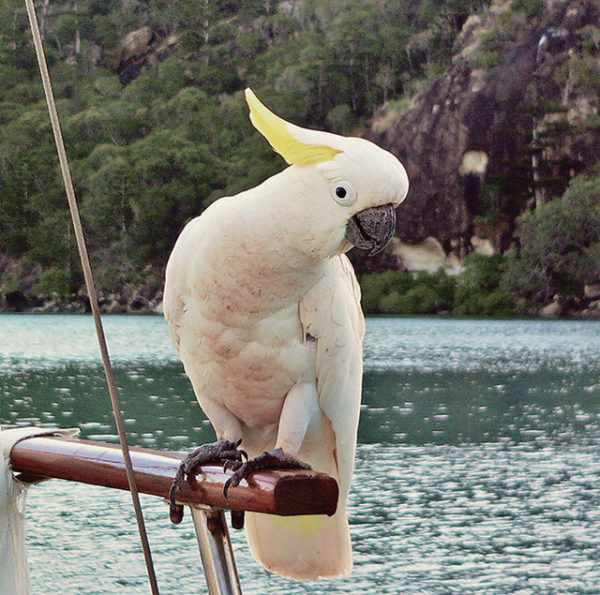Published in the Ocean Watch column, Honolulu Star-Advertiser © Susan Scott
October 8, 2016
As you read this, Craig and I are on our way to Australia once again to explore the Great Barrier Reef Marine Park on our sailboat, Honu. People assume we’re setting sail when I say that and ask, “How long will it take to get there?” As the bird flies, Australia is about 5,600 miles southwest of Hawaii. Because Honu averages 5 mph, a voyage from here to there nonstop would take six to seven weeks.
In our dreams. At 64 million square miles, the poorly named Pacific Ocean generates endless variations of tradewinds, doldrums, currents and storms that can add weeks to a long offshore voyage.
 A wild sulfur-crested cockatoo pays a visit to the Honu
A wild sulfur-crested cockatoo pays a visit to the Honu
at anchor off Hook Island, Whitsunday Islands National Park.
©2016 Susan Scott
But few skippers sail directly from Hawaii to Australia, or vice versa. We do it in hops. For my first voyage Down Under, I sailed via Palmyra Atoll, Tahiti, the Cook Islands, Tonga, Fiji and New Caledonia. The second time I added the Marquesas, the Tuamotus and Niue to the westward run. Because I took my time visiting those South Pacific islands and flew home during cyclone seasons, my answer to how long it took to sail to Australia is, “Ten years.”
Now Honu is in Australia to stay. The decision to keep the boat there was made easy by the Great Barrier Reef Marine Park Authority, or GBRMPA. For sailing, snorkeling, diving, beachcombing and hiking among friendly hosts who make great food (meat pies, yes!), it’s as good as it gets.
That coral wall we all picture when we mention the GBR is superb, but getting out there in a 37-foot sailboat can be a challenge.
Usually we must leave the night before so we arrive in high sun, critical for dodging coral heads. And because the submerged reefs offer little protection from the open ocean’s wind and waves, flat, calm water is essential. That means motoring, which is fine as long as we have plenty of diesel fuel. And if the wind and swells start up while we’re out there, we hightail it back.
But not going to the outer reefs is an excellent option because the more user-friendly parts of the park — atolls, islands and mainland rivers — offer calm anchorages, drop-dead scenery, astonishing marine life and charming avian visitors.
Honu waits for us now in a marina in Townsville, the headquarters of GBRMPA. The lovely town is visitor-friendly and so close to coral reefs that I highly recommend a visit.
After 10 years of sailing Honu across the South Pacific, the fact that I can leave Honolulu this morning and sleep on the boat tonight feels nothing short of a miracle. This time when someone asks how long it took to get to Australia, I’m very happy to say, “Twelve hours.”